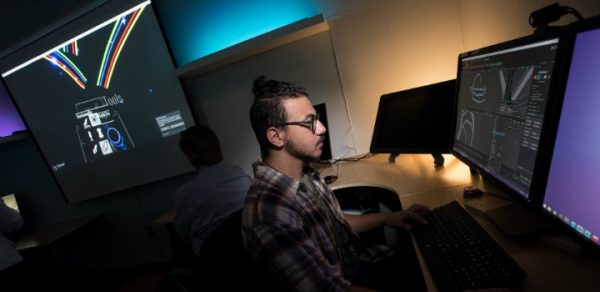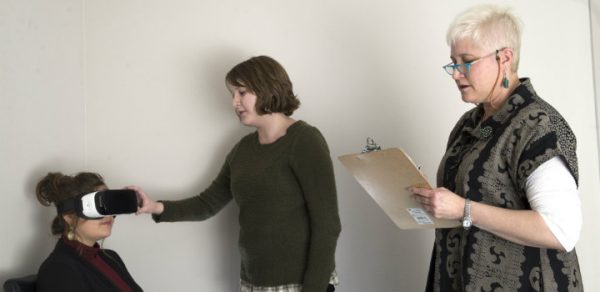
One of the newest research facilities at Northern Arizona University doesn’t incorporate beakers and chemicals. There are no lab coats or protective goggles. Instead, the Virtual Reality Lab is set up with only computers, a projector, a blank wall, and futuristic headsets.
And yet, the IVR lab is set to innovate the way students learn at NAU.
The previous Director of the IVR Lab, explains the purpose and possibilities of the lab.
“When I started to think about what this technology could do, I realized that we could really contribute to learning and research, which is essentially the primary mission of NAU,” he says. “We’re starting to write NSF grants, a 1.9 million dollar, and it’s essentially become a way now for the communication department to become research relevant.”
Interaction on a molecular level
One of the projects that the lab is currently working on explores molecular structures. The goal is to empower students to view the molecules at a subatomic level and actually break down and reconstruct them, adding another layer of hands-on possibilities that are interwoven with NAU’s curriculum.
The current work will eventually be incorporated into the curriculum for Dr. Clifford Coss’s organic chemistry class sections to help students more easily understand the complex topics discussed.
“Teachers traditionally just chalkboard-draw abstractions. I think that’s a problem because it’s less engaging, and they can’t translate a 2D graph into a 3-dimensional abstraction,” the director says. “And the 3D representations are just that—only representations of molecular structures—so they’re abstractions in and of themselves. But once the students have a more tangible sensation of what those structures are, all of a sudden they can engage with it.”
Students will soon have the opportunity to use virtual reality to build the molecular structures they’re learning about with quizzes and activities incorporated into their regular chemistry curriculum.
“Right now we’re just asking, ‘Is this a good idea? Is this working? Are we getting a good response?’ and then creating a new module based on the feedback,” he explains.
In fall 2016, the lab began trial runs across the university with senior researchers for other project topics that run the gamut from tinnitus to the ancient Mayans. The Mayan simulation takes students through a day in the life of a Mayan. Rather than reading about it in textbooks or studying ancient artifacts, students will experience the bustling marketplace and cultural interactions as if they were walking through the past.
“In general, we’ve found that for almost everything people have brought to us, we can offer some sort of solution, which is really interesting,” he says.

Beyond the classroom
While the lab is changing the way students learn in classrooms, it is also opening unprecedented behind-the-scenes opportunities to learn about a technology that will proliferate exponentially in the coming years.
Based on research by Dr. Heidi Wayment titled “The Quiet Ego,” the IVR lab creates VR environments that help users reduce stress and anxiety. The goal is to see how virtual reality can alter an individual’s thoughts and outlooks on the world and themselves. Users are asked to experience the VR environments in a clinical setting where results are measured.
Student interns work in the VR lab and collaborate with researchers from across campus to gain new and exciting experiences with virtual reality. Gaining real-world knowledge, they work in the lab for a year and are responsible for everything from designing the visuals to programming them into the computer to create these new realities.
For Sidney Colwell, a junior studying visual communication with a minor in psychology, the stars aligned perfectly when she had the opportunity to get involved in the VR lab. As an intern, she helped create the realities for the Quiet Ego project and will work closely with Dr. Wayment in the clinical trials as well, taking the project full circle.
“I really hope that it’s successful proving VR is a viable way to move into things like therapy—and that I could work later with therapists to create environments for their patients that they can use to help de-stress or conduct therapy,” Colwell says. “I think it would be great if I could combine my fields in that way.”
“It’s incredible for an undergraduate visual communications major to be involved in research,” says Colwell. “It’s something not a lot of people hear about, and it’s definitely a first for me. I just feel lucky that I get to work with these kinds of people.”
The future of VR
To the director and the students working to make these innovating experiences a reality, this is only the beginning; plans to expand the lab and its capabilities have already begun.
“Over the next three years, we’re going to build a larger lab, and we’ve drafted a three- to five-year plan for research that includes technology research to see what we can do with this medium,” the director says. “We also have collaborations with senior research partners in the university that are already defined. One part is educational technologies and clinical studies—including behavioral stuff with VR— that we can integrate into the Academic Transitions Program to help benefit struggling students.”
These goals would enable the VR research change not just the university educational landscape, but also the student support landscape. The plans sound complex and ambitious, but for the director, one idea keeps him focused on the task: “One of my biggest interests is what we can do to revolutionize the way people learn and do research.”